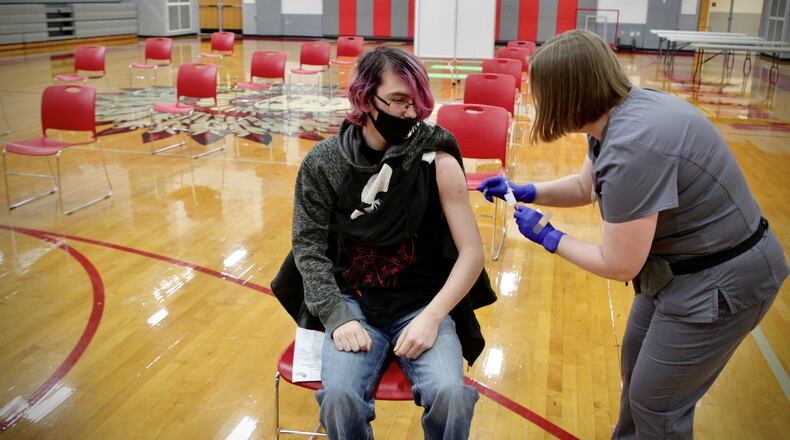Dr. Joseph P. Allen, a doctor at Premier Health Family Care of Vandalia, said families don’t feel as much urgency when it comes to getting kids vaccinated.
“You see a lot of like grandma and grandpa got vaccinated, mom and dad got vaccinated for whatever reason and then the 12-, 13- or 14-year-old is not vaccinated,” he said. “It’s just they haven’t sorted it out. It just hasn’t become convenient for them to get it yet. … And if we look at the overall impact of COVID in that population, it doesn’t have quite the dramatic impact that it does in the older population.”
While the virus does not hit kids as hard as adults, a danger still exists, Allen said.
About one in 100 kids who contract COVID-19 require hospitalization and one-third of those will require ICU care, according to data from last week’s joint report from the American Academy of Pediatrics and the Children’s Hospital Association. About one in 10,000 children who get COVID-19 die.
And even more kids who get COVID-19 will experience long-haul symptoms for months (possibly years) like headache, fatigue and heart palpitations, even if their initial symptoms are mild. Researchers have struggled to pin down how many kids experience long-haul symptoms and for how long. Studies have found that between 10% and 50% of kids report COVID symptoms months after being infected.
Experts explain that while it’s unknown if the delta variant of the virus sweeping through the country is more deadly than previous strains, the delta variant is more than twice as transmissible as previous variants. And since more kids are getting sick, statistically more kids are going to be hospitalized, experience long-haul symptoms and die.
Just a few weeks into the academic year, more than 200 school children in Montgomery, Warren, Greene and Miami counties have tested positive for COVID-19, according to the Ohio Department of Health’s latest figures, which lag significantly.
Unvaccinated kids can also provide a space for the virus to mutate and spread, including to adults who are vaccinated as rare breakthrough infections are possible.
How many kids are vaccinated?
The U.S. Food and Drug Administration gave the Pfizer-BioNTech coronavirus vaccine emergency use authorization for those 12 and older in May. On Monday, the FDA granted Pfizer’s vaccine full approval for 16 and older.
It’s difficult to know what percentage of eligible school kids and school kids in general in local counties are vaccinated. ODH’s website breaks down percent vaccinated by age groups that the U.S. Census uses. Children are lumped into one 0-19 category.
Looking at all 0-19 year-olds, as of Friday, Dayton-area counties range from 6% in Darke County to 23% in Warren County having gotten at least one shot. But that includes thousands younger than 12 who aren’t eligible for a shot, making the percentages lower.
| County | Residents 0-19 with at least one dose | % of residents 0-19 with at least one dose |
|---|---|---|
| Butler | 17,795 | 17.3% |
| Champaign | 824 | 8.6% |
| Clark | 4,212 | 12.5% |
| Darke | 789 | 6.0% |
| Greene | 7,058 | 17.2% |
| Miami | 2,839 | 10.6% |
| Montgomery | 20,093 | 15.4% |
| Preble | 769 | 7.7% |
| Warren | 14,593 | 23.4% |
As of Wednesday, close to 400,000 Ohioans ages 12-18 (about 38%) had received at least one dose of the coronavirus vaccine, according to ODH spokeswoman Alicia Shoults.
According to Public Health-Dayton & Montgomery County’s estimate, approximately 38% of Montgomery County residents age 12 to 18 had received at least one coronavirus shot as of Thursday.
What parents are saying
The Dayton Daily News conducted an online survey about vaccinations. One Warren County parent who has received the shot said their eligible child has not been vaccinated because they are “concerned about the safety down the line.”
Many parents said they were concerned about long-term effects of the shot in kids, that the vaccine had not been thoroughly researched and that children are at little risk if they get the virus.
Experts agree that the vaccine has undergone rigorous testing, and that the virus poses a far greater risk to children than getting the shot.
Angela Bailey, a parent of children in Dayton Public Schools, said her 15-year-old daughter has been vaccinated. She said getting her daughter vaccinated was about protecting her and protecting others.
“I am a believer in science, but I am also a Christian mother, former pastor of an evangelical congregation,” Bailey said.
Corey Smith, a nurse from Lebanon, said she is confident in the science. Her 14-year-old son received the shot.
“My son really wanted to play football. He did not get to play football last year because my husband and I did not feel it was safe,” she said. “That he wanted to play football and get back to school in-person has really been his driving factor.”
What might increase uptake
Local health experts speculate that the following could increase coronavirus vaccination rates in kids somewhat: FDA’s full approval of Pfizer for 16 and up this week, Ohio’s Medicaid plans beginning this week to offer $100 to child patients who get vaccinated, primary care doctors offering the vaccine in their office, schools holding clinics and a desire to avoid a child missing school to quarantine.
According to a Kaiser Family Foundation survey from June, about 30% of unvaccinated Americans said they would be more likely to get the shot if the FDA fully approved one.
But Allen said he’s skeptical the FDA’s announcement will convince many.
“I imagine some of those same people are just going to shift their arguments to something else,” he said. “They didn’t want to get it and that was a good kind of go-to for them.”
Ohio’s Medicaid Managed Care plans announced on Monday expansion of a $100 gift card incentive for getting the coronavirus vaccine to include every Medicaid patient 12 and older. The program previously was only offered to adult Medicaid patients.
Donna Gabbard, director of women and children’s health at CareSource, said they already have seen an increase in people coming to vaccination clinics to claim their gift cards. Nearly half of Ohio’s children are covered by Medicaid.
The Kaiser Family Foundation found in February that Americans would feel most comfortable getting the shot at their doctor’s office, and in June found that people trust their personal doctors much more for information on vaccines than other sources such as state government officials.
Dayton Children’s Pediatrics began offering the shot at its office this week. Dr. Jennifer Hilgeman, a pediatrician there, said it has absolutely helped increase vaccinations.
“When you have a captive audience and you can have that live one-on-one discussion with them when you’re talking about risks, benefits, going over any concerns that the parents have for the vaccine, and you’re able to offer it there on the spot and monitor them afterwards in their doctor’s office, I think the parents just feel overall more a sense of comfort in receiving it there,” she said.
The coronavirus shot is now widely available across Ohio in pharmacies and clinics run by hospitals and health departments. But the vaccine is still not offered in most doctor’s offices for logistical reasons, including that the vaccine needs to be stored at ultra-cold temperatures and it comes in multi-dose vials.
“If somebody wanted the shot in our office, I’d have to take out the whole 11-dose vial, give them one and hope I got 10 more people in the next few hours,” Allen explained. “That just doesn’t work well. You’d have to have a huge tolerance for waste.”
Many local school districts held vaccination clinics at the end of last school year but few are doing so now.
“The majority of the districts in Montgomery County, it’s not that they don’t want to host the clinic. They’re willing to do that,” said Shannon Cox, superintendent of the Montgomery County Educational Service Center. “It’s just that when they offered their last ones in the spring, there was such low turnout that they feel like there needs to be a change in something before they offer the next one.”
Cox said the FDA fully approving the shot for those 12-15 or giving emergency authorization for students younger than 12 could lead to more schools holding clinics again.
Mad River Schools is one of the few districts planning a clinic this fall. Eligible students will have the opportunity to get the vaccine from Premier Health during the school day at the high school, and middle school students will have transportation provided if they sign up for the clinic. More than 40 parents have already expressed interest in signing their kids up, Mad River spokeswoman Jenny Alexander said.
“But that doesn’t mean we won’t get more since school will be in session,” she said. “We’re trying to be healthy and safe, and give our parents and kids the opportunity to receive the vaccine in a safe and efficient way.”
Lastly, now that students are returning to school, where they might be exposed to COVID-19 and need to quarantine and miss school, school and health leaders predict an uptick in vaccinations.
Most schools are following Ohio Department of Health guidance on quarantining, which states that schools that are following the same stringent protocols from last academic year, including universal masking and maximizing physical distancing, do not have to send students and staff exposed to a positive coronavirus case in the classroom home to quarantine. But if a student or staff member is not wearing a mask and not vaccinated when they are exposed, they should quarantine.
“Vaccinations are a big thing to help kids stay in school and stay in school safely,” Hilgeman said. “So that can help sway parents and also just help them feel reassured that if my kid’s vaccinated, they should be safe at school.”
About the Author

